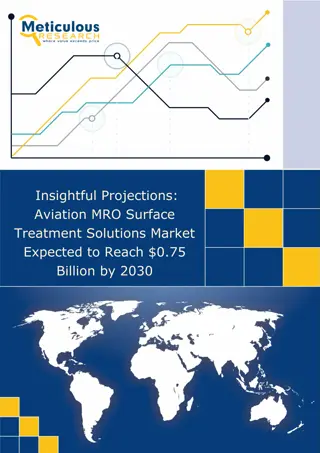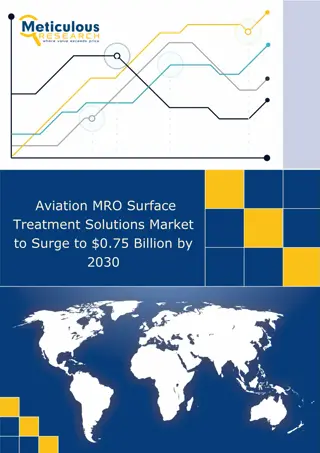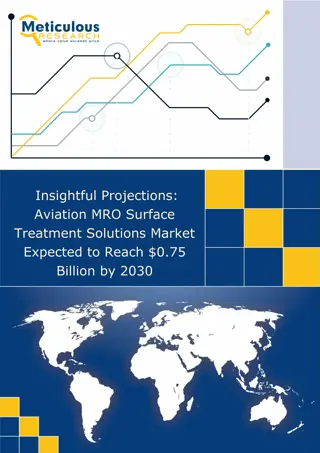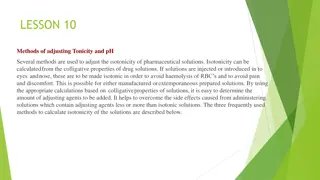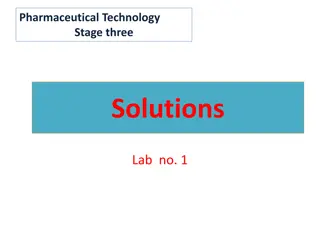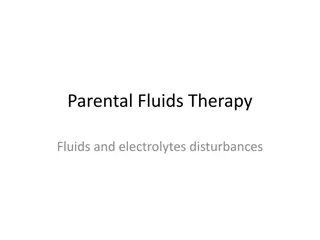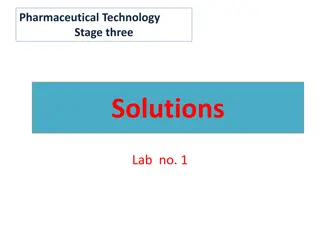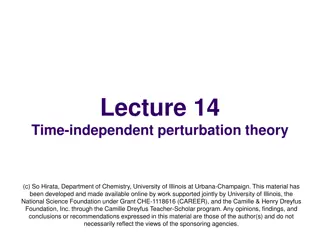Solutions (Chapter 16)
Dive into the world of mixtures and solutions with insights on new terminology, separation methods, solution concentrations, and examples. Explore homogeneous and heterogeneous mixtures, solution components, and unique characteristics of various solutions like alloys, dental amalgams, and colloids.
Uploaded on Feb 24, 2025 | 0 Views
Download Presentation

Please find below an Image/Link to download the presentation.
The content on the website is provided AS IS for your information and personal use only. It may not be sold, licensed, or shared on other websites without obtaining consent from the author.If you encounter any issues during the download, it is possible that the publisher has removed the file from their server.
You are allowed to download the files provided on this website for personal or commercial use, subject to the condition that they are used lawfully. All files are the property of their respective owners.
The content on the website is provided AS IS for your information and personal use only. It may not be sold, licensed, or shared on other websites without obtaining consent from the author.
E N D
Presentation Transcript
Solutions (Chapter 16) Dr. Walker
What will you learn? New terminology for mixtures How to separate mixtures How to determine solution concentrations
A Review. What is a mixture? A combination of two or more compounds What are two kinds of mixtures? Homogeneous: evenly distributed Heterogeneous: not evenly distributed
New Terminology Solution Another term for a homogeneous mixture Associated with liquids, but can have a gaseous solution (i. e., air) Can have a solid-solid solution Alloy: mixture of metals Steel = Iron + Carbon Brass = Copper + Zinc Bronze = Tin + Aluminum
Solution Examples States of matter in solutionExample gas in gas air ( N2, O2, Ar, CO2, other gases) soda (CO2in water) gasoline (a mixture of hydrocarbon compounds) sea water ( NaCl and other salts in water) H2in platinum or palladium gas in liquid liquid in liquid solid in liquid gas in solid dental amalgams ( mercury in silver) alloys ( brass, (Cu/Zn), solder (Sn/Pb) liquid in solid solid in solid
New Terminology Miscible Liquids that are soluble in any proportion and form a solution Example: Water and alcohol you can have 90% water or 90% alcohol and it will dissolve either way. Solids have a limit to how much can dissolve. Miscible liquids do not!
Parts of a Solution The chemical that is dissolved is the solute The chemical that does the dissolving is the solvent (majority component)
Solution Examples Soda What is the solvent? Water What is (are) the solute(s)? Carbon dioxide Sugar Flavorings Preservatives
Colloids Homogeneous mixture with large particles They look murky (you can t see through them) and scatter light (fog vs. headlights) Solutions are clear (if liquid or gas) Examples: Fog Milk Soap
Separating Mixtures Decanting Pour off the solvent, leave the solute. Used in suspensions. An example of this is dirt in water. Once the dirt settles, the water can be carefully poured off, leaving the dirt. Suspension = heterogeneous mixture
Separating Mixtures Mixture of solid and liquid Stirring rod Filtration: A piece of paper is placed in a funnel. The suspension is poured in. The solvent passes through, the solid solute gets caught in the funnel. Separates by particle size using paper. The most common example of this is making coffee. The water passes through the filter and picks up soluble components in the coffee. The grounds are left in the coffee filter. Funnel Filter paper traps solid Filtrate (liquid component of the mixture) Zumdahl, Zumdahl, DeCoste, World of Chemistry 2002, page 40
Separating Mixtures Centrifuge Separates components of a mixture with different densities by spinning at very high speed. These are used to separate components in blood (plasma, platelets, etc.). Evaporation If you have a salt water solution, if you evaporate the water, you re left with the salt.
Biological Centrifuge Equipment http://upload.wikimedia.org/wikipedia/commons/0/0d/Tabletop_centrifuge.jpg
Separating Mixtures Chromatography Separates mixtures based on adhesion of compounds to a solid (how well compounds stick to something). An example is separating dyes in inks. The different inks move at a different rate through special paper (the solid) based on their chemical structure.
Chromatography http://www.moe.gov.sg/edumall/tl/digital_resources/chemistry/images/paper_chromatography.jpg
Separating Mixtures Distillation Separates solutions based on differences in boiling point. Fermentation of sugar in water produces alcohol, which is found in beer, wine, etc. An alcohol/water mixture boils at a lower temperature than water, so it separates out. Another example is separating different petroleum products from crude oil.
Solubility Like Dissolves Like Polar solvents dissolve polar solutes Water and alcohol are both polar and they are miscible Nonpolar solvents dissolve nonpolar solutes Oil and gas are soluble, some small engines require premixing Polar + Nonpolar = no mixing! Think oil and water they don t mix! Italian salad dressing = oil and vinegar = two layers!
Polarity Review Polar molecules Difference in electronegativity Three dimensional asymmetry Covalent: Bent (H2O), Trigonal Pyramidal (NH3) shapes Compounds with oxygen and nitrogen (electronegative elements) Ionic compounds polar by default Nonpolar molecules Tetrahedral (CCl4) shape Hydrocarbons (CH4, C3H8, C8H18)
Solubility Solubility The maximum amount of a substance that will dissolve in a given amount of solvent at a specified temperature. How much solute does it have? Unsaturated: It could hold more solute than it has Saturated: It has the maximum amount of solute Supersaturated: It has too much solute Supersaturated solutions crystallize when disturbed More stable at high temperatures
Solubility Curves Different compounds have different solubilities More of some things can dissolve than others
Solubility Curves Which has the highest solubility at 90 oC? Which has the highest solubility at at 20 oC? On which material does temperature have the lowest effect on solubility?
Solubility Curves Which has the highest solubility at 90 oC? KNO3 Which has the highest solubility at at 20 oC? NaClO3 On which material does temperature have the lowest effect on solubility? NaCl
Solubility Solubility in a solvent is usually dependent on: Temperature More solute can dissolve at a higher temperature (in most cases) Example: more sugar can dissolve in boiling water than room temperature water Surface area Solute dissolves faster with more surface area Crystalline sugar dissolves faster than sugar cubes more interaction with the solvent
Colligative Properties Colligative properties are properties of a solution that change with the addition of solute or when the solute concentration changes Freezing Point Depression Boiling Point Elevation Vapor Pressure The number of solute particles changes the freezing point and boiling point of a pure substance.
A Real World Example Antifreeze Ethylene Glycol Increases boiling point (works as coolant) Decreases freezing point (works as antifreeze) Concentration dependent
A Real World Example Calcium Chloride (CaCl2) Used to melt icy roads, mixed with sand Works by decreasing the freezing point of water
A Real World Example Boiling Point Changes with Elevation Higher altitude = lower pressure Less atmosphere pushing down Boiling point for water at sea level = 100 C Boiling point for water in Denver (1 mile up) = 95 C Boiling point for water on Mt. Everest (5 miles up) = 72 C http://www.madsci.org/posts/archives/2000-12/976811375.Es.r.html
Concentration Amount of material dissolved in a solvent Several potential units Molarity (moles solute per liter solution) Molality (liters solute per kg solvent) Parts per million
Molarity We will use molarity
Molarity The equation includes moles and liters, so information MUST be in these units before plugging into the equation If grams are given, divide by molar mass to get moles If milliliters are given, divide by 1000 to get liters
Molarity Example #1 Give the molarity of a solution containing 0.25 moles NaCl with a total volume of 0.2 L.
Molarity Example #1 Give the molarity of a solution containing 0.25 moles NaCl with a total volume of 0.2 L. 0. 25 moles ___________ M = = 1.25 M 0.2 L
Molarity Example #2 Give the molarity of a solution containing 7.45 g KCl with a total volume of 400 mL
Molarity Example #2 Give the molarity of a solution containing 7.45 g KCl with a total volume of 400 mL Convert units (7.45 g / 74.55 g/mole) __________________ (400 mL / 1000 mL) M = = 0.25 M
Molarity Example #3 How many moles of CaO are contained in 0.8 L of a 0.25 M solution?
Molarity Example #3 How many moles of CaO are contained in 0.8 L of a 0.25 M solution? moles _________ 0.8 0.25 M = Moles = 0.2
Molarity Example #4 How many grams of glucose (C6H12O6) are required to make 500. mL of a 0.20 M solution?
Molarity Example #4 How many grams of glucose (C6H12O6) are required to make 500. mL of a 0.20 M solution? 1) Plug in and find moles first 2) Convert to grams with molar mass moles Moles = 0.1 _________ (500 mL / 1000 ) 0.2 M = 0.1 moles x 180.18 g/mole = 18.0 g
Dilutions Sometimes you have to use a solution at one concentration to make a more dilute one Or the some of the solution evaporates and the concentration changes You have to figure out how much solvent to add
Dilutions The long way Find unknown from the molarity equation Plug into second molarity equation We won t do this! The short way Dilutions M1V1 = M2V2 M = concentration (Molarity), V = volume
Dilution Example What volume of a 3.0 M solution of HCl is required to make 500 mL of 0.5 M HCl?
Dilution Example What volume of a 3.0 M solution of HCl is required to make 500 mL of 0.5 M HCl? The numbers that go together and M1 and V1 M1V1 = M2V2 (0.5 M)(500 mL) = (3.0 M)V2 V2 = 83.33 mL
Dilution Example 300 mL of a 1.5 M sucrose solution is allowed to sit on the countertop. After 24 h, 50 mL has evaporated. What is the new concentration of the solution?
Dilution Example 300 mL of a 1.5 M sucrose solution is allowed to sit on the countertop. After 24 h, 50 mL has evaporated. What is the new concentration of the solution? M1V1 = M2V2 (1.5 M)(300 mL) = M2(300 50 mL) 1.8 M = M2








